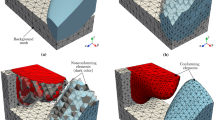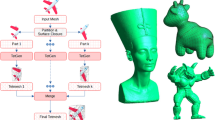Abstract
We present a practical and stable algorithm for the parallel refinement of tetrahedral meshes. The algorithm is based on the refinement of terminal-edges and associated terminal stars. A terminal-edge is a special edge in the mesh which is the longest edge of every element that shares such an edge, while the elements that share a terminal-edge form a terminal star. We prove that the algorithm is inherently decoupled and thus scalable. Our experimental data show that we have a stable implementation able to deal with hundreds of millions of tetrahedra and whose speed is in between one and two order of magnitude higher from the method and implementation we presented (Rivara et al., Proceedings 13th international meshing roundtable, 2004).





Similar content being viewed by others
References
Barker K, Chernikov A (2004) Nikos Chrisochoides, and Keshav Pingali. A load balancing framework for adaptive and asynchronous applications. Trans Parallel Distrib Syst 15(2):183–192
Blelloch G, Hardwick J, Miller G, Talmor D (1999) Design and implementation of a practical parallel delaunay algorithm. Algorithmica 24:243–269
Nave D, Chrisochoides N, Chew LP (2004) Guaranteed-quality parallel delaunay refinement for restricted polyhedral domains. Comput Geom: Theor Appl 28(2–3):191–215
Chew LP, Chrisochoides N, Sukup F (1997) Parallel constrained Delaunay meshing. In: ASME/ASCE/SES summer meeting, special symposium on trends in unstructured mesh generation, pp 89–96, Northwestern University, Evanston, IL, 1997
Chrisochoides N (2006) Numerical solution of partial differential equations on parallel computers, volume in print. Chapter A survey of parallel mesh generation methods. Springer, Berlin Heidelberg New York
Chrisochoides N, Houstis E, Rice J (1994) Mapping algorithms and software environment for data parallel PDE iterative solvers. J Parallel Distrib Comput 21(1):75–95
Chrisochoides N, Nave D (2000) Simultaneous mesh generation and partitioning. Math Comput Simulation 54(4–5):321–339
Chrisochoides N, Nave D (2003) Parallel Delaunay mesh generation kernel. Int J Numer Meth Eng 58:161–176
Chrisochoides NP (1996) Multithreaded model for load balancing parallel adaptive computations. Appl Numer Math 6:1–17
de Cougny H, Shephard M (1999) Parallel volume meshing using face removals and hierarchical repartitioning. Comp Meth Appl Mech Eng
Galtier J, George PL (1997) Prepartitioning as a way to mesh subdomains in parallel. In: Special symposium on trends in unstructured mesh generation. ASME/ASCE/SES
Gutierrez F (2003) The longest edge bisection of regular tetrahedron. In: Personal communication
Hitschfeld N, Rivara MC (2002) Automatic construction of non-obtuse boundary and/or interface delaunay triangulations for control volume methods. Int J Numer Meth Eng 55:803–816
Hitschfeld N, Villablanca L, Krause J, Rivara MC (2003) Improving the quality of meshes for the simulation of semiconductor devices using lepp-based algorithms. Int J Numer Meth Eng 58:333–347
Ito Y (2004) Advance front mesh generator. Unpbulished Software, March
Jones MT, Plassmann PE (1994) Parallel algorithms for the adaptive refinement and partitioning of unstructured meshes. In: Proceedings of the scalable high-performance computing conference
Kot A, Chrisochoides N (2004) “green” multi-layered “smart” memory management system. Int Sci J Comput 2(3):91–97
Linardakis L, Chrisochoides N (2006) Delaunay decoupling method for parallel guaranteed quality planar mesh generation. SISC 27(4): 1394–1423
Lohner R, Cebral J (1999) Parallel advancing front grid generation. In: International meshing roundtable. Sandia National Labs
Rivara MC (1984) Design and data structure of fully adaptive multigrid, finite element software. ACM Trans Math Softw 10:242–264
Muthukrishnan SN, Shiakolos PS, Nambiar RV, Lawrence KL (1995) Simple algorithm for adaptative refinement of three-dimensionalfinite element tetrahedral meshes. AIAA J 33:928–932
Nambiar N, Valera R, Lawrence KL, Morgan RB, Amil D (1993) An algorithm for adaptive refinement of triangular finite element meshes. Int J Numer Meth Eng 36:499–509
Nave D, Chrisochoides N, Chew LP (2002) Guaranteed-quality parallel Delaunay refinement for restricted polyhedral domains. In: Proceedings of the eighteenth annual symposium on computational geometry, pp 135–144
José G. Castaños, John E. Savage (1997) The dynamic adaptation of parallel mesh-based computation. In: SIAM 7th symposium on parallel and scientific computation 1997
José G. Castaños, John E. Savage (1999) Pared: a framework for the adaptive solution of pdes. In: 8th IEEE symposium on high performance distributed computing
Okusanya T, Peraire J (1997) 3D parallel unstructured mesh generation. In: Trends in unstructured mesh generation, pp 109–116
Rivara MC (1984) Algorithms for refining triangular grids suitable for adaptive and multigrid techniques. Int J Numer Meth Eng 20:745–756
Rivara MC (1989) Selective refinement/derefinement algorithms for sequences of nested triangulations. Int J Numer Meth Eng 28:2889–2906
Rivara MC (1997) New longest-edge algorithms for the refinement and/or improvement of unstructured triangulations. Int J Numer Meth Eng 40:3313–3324
Rivara MC, Hitschfeld N, Simpson RB (2001) Terminal edges Delaunay (small angle based) algorithm for the quality triangulation problem. Comput-Aided Des 33:263–277
Rivara MC, Levin C (1992) A 3D refinement algorithm for adaptive and multigrid techniques. Commun Appl Numer Meth 8:281–290
Rivara MC, Palma M (1997) New lepp algorithms for quality polygon and volume triangulation: implementation issues and practical behavior. In: Cannan SA, Saigal AMD (eds) Trends unstructured mesh generationi, Vol. 220, pp 1–8
Rivara MC, Pizarro D, Chrisochoides N (2004) Parallel refinement of tetrahedral meshes using terminal-edge bisection algorithm. In: Proceedings 13th international meshing roundtable, Williamsburg, Virginia, pp 427–436
Said R, Weatherill N, Morgan K, Verhoeven N (1999) Distributed parallel delaunay mesh generation. Comp Meth Appl Mech Eng 177:109–125
Simpson RB, Hitschfeld N, Rivara MC (2001) Approximate quality mesh generation. Eng Comput 17:287–298
Spielman DA, Teng S-H, Üngör A (2001) Parallel Delaunay refinement: algorithms and analyses. In: Proceedings of the eleventh international meshing roundtable, pp 205–217
Williams R (1991) Adaptive parallel meshes with complex geometry. Numerical grid generation in computational fluid dynamics and related fields
Acknowledgments
The C++ code RemGO3D was developed at the University of Chile under grant Fondecyt 1040713. The parallel results were obtained by using computational facilities at the College of William and Mary which were enabled by grants from Sun Microsystems, the National Science Foundation, and Virginia’s Commonwealth Technology Research Fund. We thank the referees whose comments helped to improve the paper and Daniel Pizarro who wrote the previous Java implementation.
Author information
Authors and Affiliations
Corresponding author
Additional information
Maria-Cecilia Rivara and Carlo Calderon's work was partially supported by Fondecyt 1040713.
Andriy Fedorov’s work is supported in part by ITR #ACI-0085969, and NGS #ANI-0203974.
Nikos Chrisochoides’s work is supported in part by NSF Career Award #CCR-0049086, ITR #ACI-0085969, NGS #ANI-0203974, and ITR #CNS-0312980.
Rights and permissions
About this article
Cite this article
Rivara, MC., Calderon, C., Fedorov, A. et al. Parallel decoupled terminal-edge bisection method for 3D mesh generation. Engineering with Computers 22, 111–119 (2006). https://doi.org/10.1007/s00366-006-0013-2
Received:
Accepted:
Published:
Issue Date:
DOI: https://doi.org/10.1007/s00366-006-0013-2




